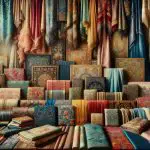If you’re a fan of vintage textiles, you may have heard of a cutter quilt. But what exactly is a cutter quilt?
Essentially, a cutter quilt is a quilt that has been deemed unusable due to damage or wear and tear. While this may seem like a sad fate for a quilt, cutter quilts can actually be a fascinating and valuable piece of history.
Cutter quilts were often made from scraps of fabric and were meant to be functional rather than decorative. Over time, these quilts would become worn or damaged, making them unsuitable for their original purpose.
However, savvy collectors and crafters have found new uses for cutter quilts, such as using them for DIY projects or repurposing them into new quilted items.
In this article, we’ll explore the history and characteristics of cutter quilts, as well as tips on identifying, collecting, repairing, and using them in your own projects.
Table of Contents
Definition and History of Cutter Quilts
Cutter quilts are quilts that have been repurposed or ‘cut up’ for other uses, often due to wear or damage, and they have a unique history and charm.
These quilts have a long history, dating back to the early 1900s when fabric was expensive and people would often use everything they had until it was completely worn out. At this point, the quilt would be cut into smaller pieces and used for other things.
As the years went by, cutter quilts became more popular as they were used not only for practical purposes but also for decorative ones. The unique patterns and colors of the quilts made them perfect for use in home décor and clothing.
Many people even started collecting cutter quilts as a way to preserve their history and beauty. Today, cutter quilts are still sought after by many people.
They have become a symbol of a simpler time when things were made to last and were not thrown away easily. Whether used for their original purpose or for something new, cutter quilts continue to be treasured for their unique history and charm.
Characteristics of Cutter Quilts
You’ll notice how these quilts have a well-loved, vintage feel to them due to their frayed edges and worn fabrics. Most cutter quilts were made from scraps of fabric that weren’t usable for clothing or other purposes.
This is why you’ll see a variety of fabrics and patterns within one quilt. Another characteristic of cutter quilts is that they often have irregular shapes and sizes. This is because the quilter would use whatever fabric scraps they had available and would piece them together in a way that made sense.
As a result, cutter quilts can be quite unique and interesting to look at. Cutter quilts were often made for utilitarian purposes rather than for show. This means that they were meant to be used and enjoyed, which is why you’ll often see signs of wear and tear on them.
Despite their imperfections, cutter quilts are beloved by many people for their charm and history.
Identifying Cutter Quilts
If you come across a patchwork blanket with frayed edges and an assortment of fabrics, it may be a vintage piece known for its utilitarian charm. This type of quilt is called a cutter quilt, and it was once a treasured possession that provided warmth and comfort during cold nights.
However, over time, the quilt became worn and damaged, and it was no longer suitable for its original purpose. To identify a cutter quilt, there are a few key characteristics to look out for. Firstly, they often have frayed or uneven edges, as they were cut down from larger quilts to salvage any usable fabric.
The patchwork may also include a variety of fabrics, from cotton to wool and silk, and the patterns may not always match up perfectly. If you’re lucky enough to come across a cutter quilt, there are a few things to keep in mind.
Firstly, it’s important to handle it with care, as the fabric may be delicate and prone to further damage. Secondly, while it may not be suitable for use as a traditional quilt, it can still be repurposed into other items, such as pillow covers or wall hangings.
By doing so, you can give new life to an old and cherished piece of history.
Collecting Cutter Quilts
Acquiring vintage textiles with utilitarian charm, such as cutter quilts, can add a unique and historical element to a collection. If you’re interested in collecting cutter quilts, there are a few things to keep in mind. First, consider the condition of the quilt. Cutter quilts are often damaged or stained, but you want to make sure that the damage is not too extensive and that the quilt is still usable for its intended purpose.
Next, you’ll want to research the history of the quilt. Look for any identifying marks, such as a signature or date, that can help you trace the quilt’s origins. You can also look for clues in the fabric patterns and colors used in the quilt. Understanding the history of the quilt can add to its value and significance in your collection.
Lastly, consider the display of the quilt. Cutter quilts can be used in a variety of ways, such as a wall hanging or a tablecloth. You can also use the quilt as a throw on a couch or bed. Be creative with your display and highlight the unique features of the quilt. By following these tips, you can start a collection of cutter quilts that not only adds to your decor, but also has historical significance.
| Pros | Cons |
|---|---|
| Affordable | Often damaged |
| Unique | Limited availability |
| Historical significance | May require restoration |
Repairing and Maintaining Cutter Quilts
Maintaining the vintage charm of these textiles can be challenging, but with proper care, they can last for years to come. When it comes to repairing and maintaining cutter quilts, it’s important to handle them with care.
First, assess the damage and decide the best course of action. If there are tears or holes, patching them up with a piece of fabric that matches the original quilt is a good option. Use a needle and thread to carefully stitch the patch in place, making sure to blend it seamlessly with the rest of the quilt.
Another important aspect of maintaining cutter quilts is washing them. It’s important to be gentle with these delicate textiles, using a mild detergent and cold water. Avoid using harsh chemicals or bleach, which can damage the fabric. If possible, hand-washing is the best option, but if you must use a washing machine, place the quilt in a mesh laundry bag to protect it from getting caught or tangled.
Storing cutter quilts properly is essential for their longevity. It’s best to store them flat or rolled, rather than folded, to avoid creases that may become permanent over time. Keep them in a cool, dry place, away from direct sunlight and moisture.
If you need to store them in a container, make sure it’s clean and dry, and consider adding some acid-free tissue paper to help protect the quilt from dust and insects. With these tips in mind, you can keep your cutter quilts in great condition for years to come.
Using Cutter Quilts in DIY Projects
Get ready to add some vintage charm to your home decor with these creative DIY projects using beautiful, one-of-a-kind, handmade textiles. Cutter quilts may have holes, stains, or other imperfections, but that doesn’t mean they’re not still full of life and character.
Here are a few ideas to get you started:
-
Pillow covers: Cut the quilt into squares and sew them together to create a patchwork pillow cover. Add a simple backing fabric and a zipper closure for a polished look.
-
Wall art: Stretch a section of the quilt over a canvas or frame and hang it on the wall for a unique and cozy piece of art. You could also frame a smaller section or even just a single quilt block.
-
Table runner: Cut a long strip of the quilt and hem the edges for a charming table runner. This is a great way to add some color and texture to your dining room or kitchen.
With a little creativity and some basic sewing skills, the possibilities are endless! Don’t be afraid to experiment with different shapes, sizes, and colors to make your projects truly one-of-a-kind.
And remember, the beauty of using cutter quilts is that imperfections are part of their charm. So embrace the uniqueness of your piece and have fun creating something new and beautiful.
- The Use of Nonwovens in Construction and Civil Engineering - July 11, 2025
- The Use of Nonwovens in Construction and Civil Engineering - July 11, 2025
- The Use of Nonwovens in Construction and Civil Engineering - July 11, 2025




